
DOWNLOAD
DATE
Contact
Communication service providers (CSPs) — especially standalone operators — tend to face serious roadblocks in the initial stage of IT transformations. Discussions about IT architecture and vendor options often lead to analysis paralysis, which hinders progress to the point where operators are unable to keep pace with industry evolution. This Viewpoint provides a blueprint for mastering large-scale IT transformations.
FOCUS ON ESSENTIAL REQUIREMENTS
Many business support system (BSS) transformations fail at the initial stage. This is usually due to IT and business units including numerous requirements based on legacy systems and detailed architectural decisions, making it difficult to produce a manageable requirements list. CSPs can avoid becoming overwhelmed in the initial stage by concentrating on essential requirements using this six-step method:
-
Strategic alignment. All project stakeholders should agree on a business-driven transformation (this avoids the common but failure-prone IT-driven process).
-
Resolution plan. Create a clear architecture for how existing issues will be resolved (based on assessed/weighted scenarios). This includes make-or-buy decisions and a comprehensive decommissioning plan for legacy platforms.
-
Stack approach. Decide on a greenfield, bluefield, or brownfield approach for the transformation, factoring in that potentially substantial system integration will be needed, as no system lives in isolation.
-
Migration approach. Decide whether to pursue an iterative, staged migration or a big-bang transformation (this is rarely advisable).
-
Delivery approach. It is key to decide in early stage if the CSP has the know-how, capabilities, and experience to deliver the transformation together with the potential vendor or if engaging with a system integrator is needed.
-
Budget cap. Decide on a budget for new systems, implementation, potential change requests, and ongoing maintenance/support.
Following these six steps can help CSPs reach decisions about digital transformations significantly faster, with fewer iterations.
START WITH CLEAR TARGET, COMPREHENSIVE RFP
A well-defined strategic vision is pivotal to effective business transformation. Key decisions, especially those aimed at reducing business complexity, are fundamental to value creation. Transformations may seem challenging to CSPs, but they do not have to be, especially if they follow an expedited bidding process. For example, rather than expecting potential vendors to address hundreds or even thousands of individual features for inclusion, CSPs should ask them to provide a vision for a system that will bring their technology capabilities in line with market best practices. In other words, let outside-in innovation drive the process and transformation. This will help deliver a substantial business capability uplift, rather than relying on an inward-looking approach that results in replicating existing functionality.
PRESELECTION PROCESS
Choosing the right vendor for a transformation project is critical, and the first step is having a good selection of potential partners to pick from. This requires a thorough assessment of the integrator landscape to develop a good understanding of the differences in quality, capabilities, and pricing between vendors. CSPs should aim for a list of six to 10 vendors that appear to meet their minimum criteria (see Figure 1).
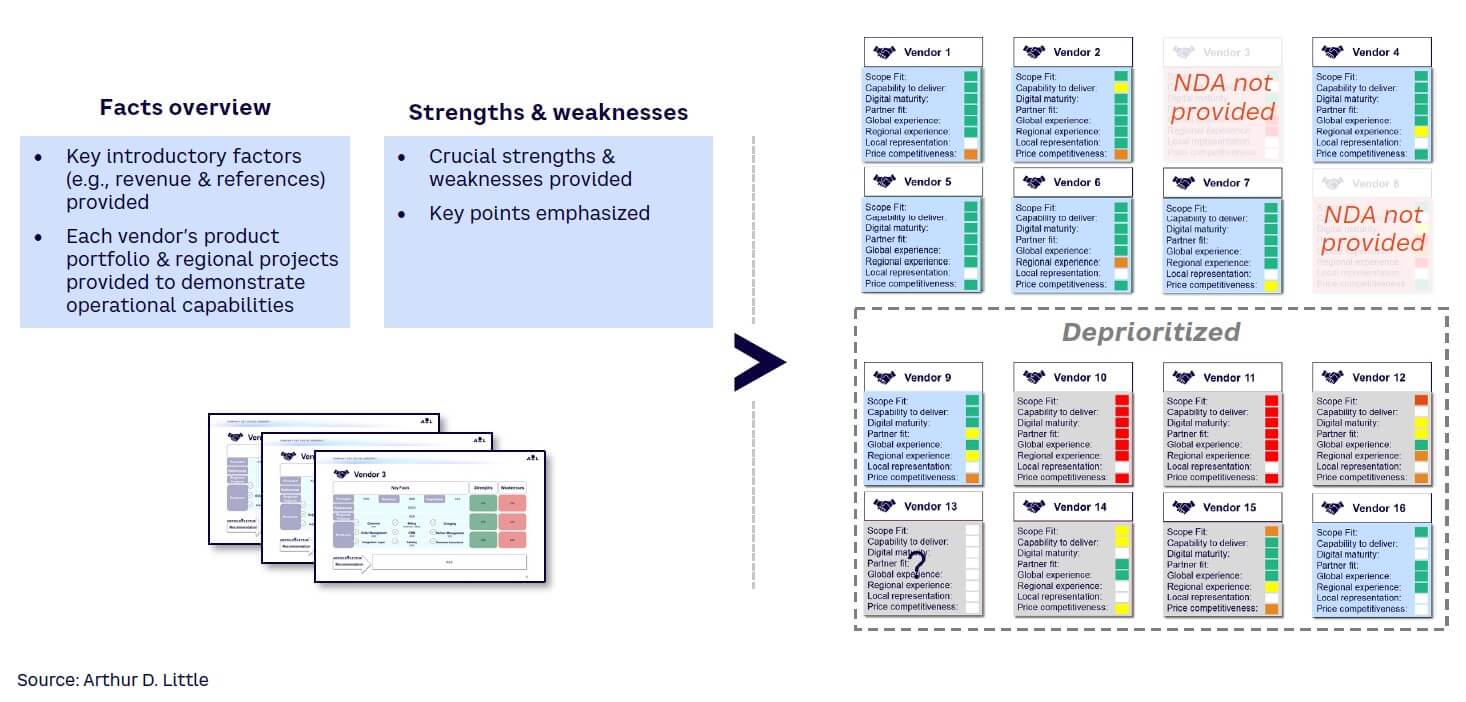
After compiling a list of potential integrators, it is critical to learn as much about each as quickly as possible. Q&A sessions can be an efficient way to do this. Project owners gain an early indication of the vendor’s commitment to the project, and vendors gain insights into the project owner’s ability to communicate and set realistic deadlines. After the Q&A, the request for proposal (RFP) should be shared with all viable candidates.
NARROWING THE FIELD
Several factors are important to keep in mind at this stage. First, selecting a vendor is not about identifying a company that can deliver the project, it’s about finding a partner that can enable long-term changes. Second, the CSP is not the only entity at risk. Vendors are also investing significant resources in the bidding process (and, indeed, in the project itself).
For these reasons, it’s critical to carefully formulate the team examining the RFPs and evaluating vendor performances. The team should include members with technical expertise, those with business expertise, and it should include as many seniority levels as possible.
Many companies are opting to test-drive vendor systems to help them determine which systems fit their requirements and identify potential issues early in the process. This often involves a one-to-several-week(s) test of each potential vendor solution on a plain-vanilla test bed, sometimes called “sandboxing.”
It’s also important to evaluate each vendor’s ability to deliver the desired migration approach and accommodate necessary change requests.
Once the two best-suited vendors have been selected, contracting and pricing negotiations can begin (see Figure 2). Ideally, CSPs should aim to complete the initial selection process in four to six weeks and spend about three weeks on final negotiations (see Figure 3). Although achieving the final contract is an important milestone, the transition team must keep in mind that its transformation journey is only just beginning.
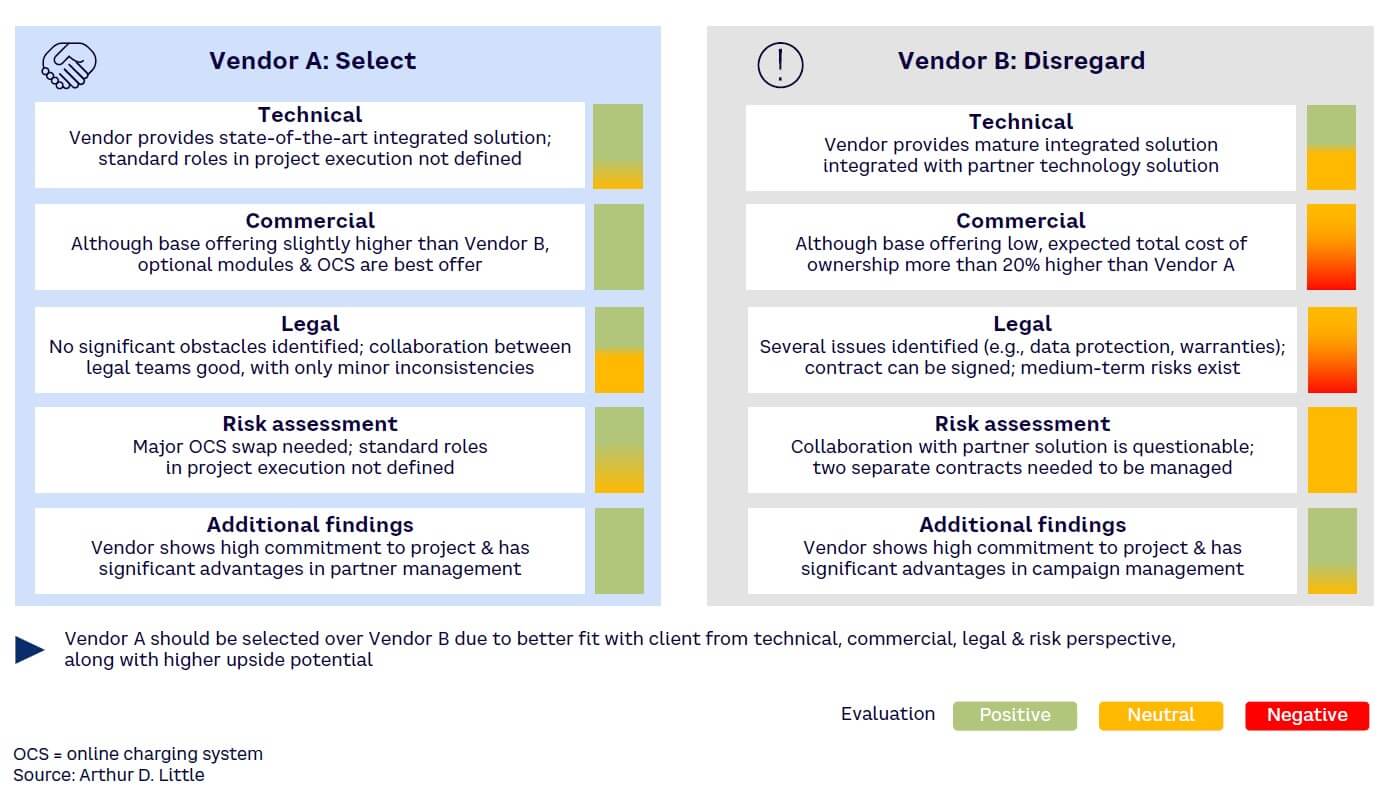
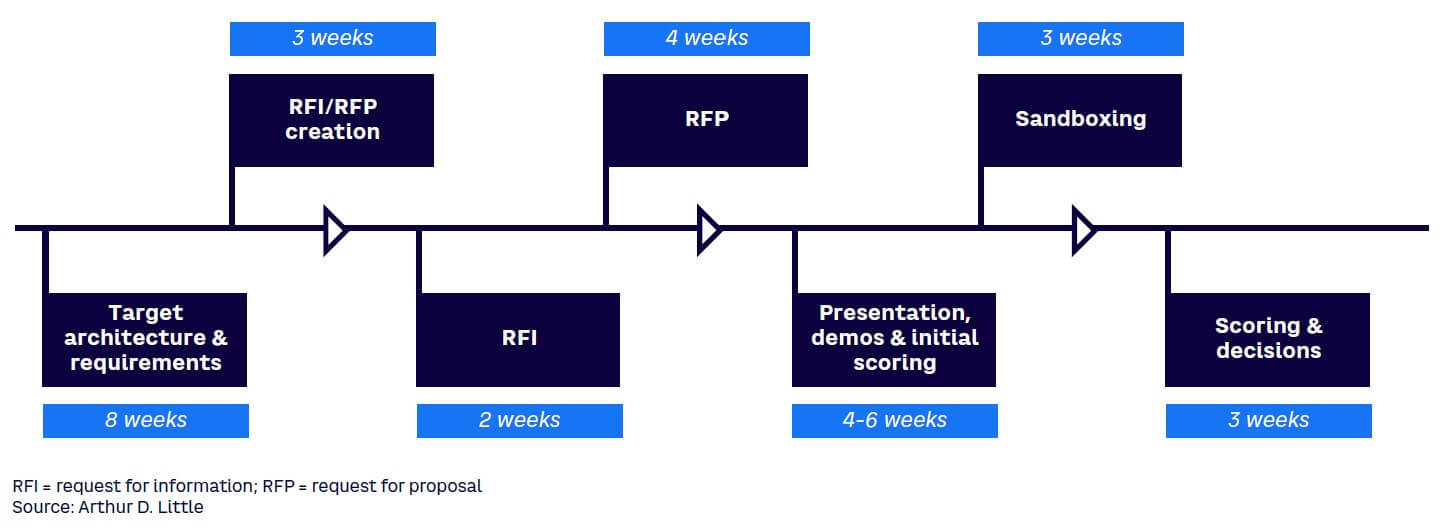
PRIORITIZE PROJECT & PREPARE FOR CHANGE
Changing the BSS — set out as a corporate transformation — will impact the way the company functions, change how customers will be served, and how business units (BUs) and IT units interact, so early and frequent communication is essential. Every employee should understand the significance of the transformation project, and the IT teams closely involved with the transformation must be ready for the initial software delivery. The CSP’s internal communications department should be tapped early on to help with both targeted and company-wide communication management.
It is also important to limit changes to the current IT system as much as possible. Limiting change requests at specific stages and instituting a hard freeze before go-live help IT stay focused on the transformation. Clearly defined out-of-the-box (OOTB) minimum thresholds, especially when mandated by top management, help reduce costs and ensure future upgradability (see Figure 4).
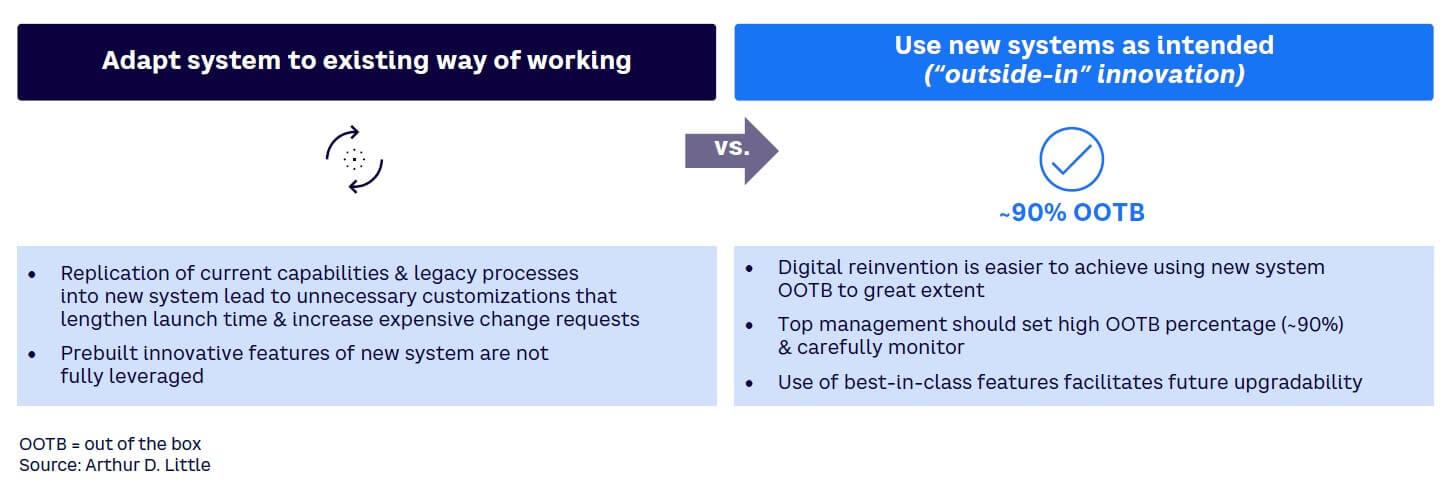
When failed transformations are examined, they often show a lack of product pruning and data cleansing prior to the migration. As-is migration (especially of complex, long-tail-prone product lineups) makes the migration process more difficult and usually leads to significant delays. Data migration complexity is often underestimated (data quality, multiple sources, etc.); therefore, migration must ensure master data management uplift and the enabling of full AI. Figure 5 shows how BUs and IT need to focus on product complexity/quantity reduction in the legacy system.
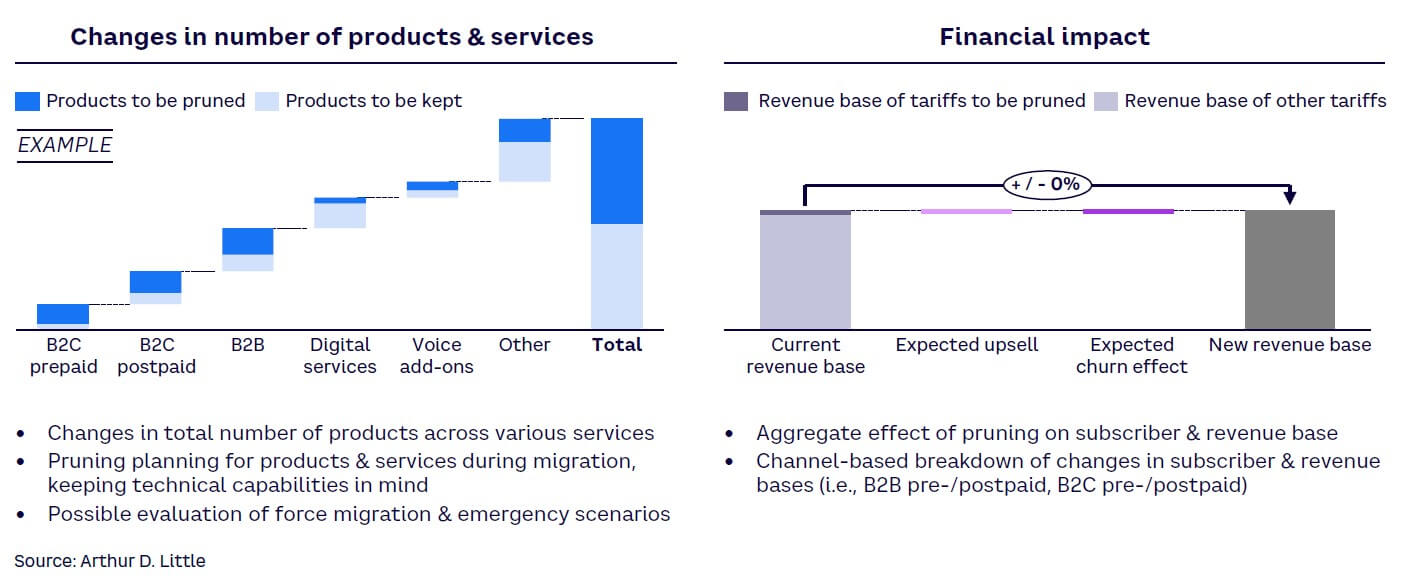
A culture of change is another crucial factor for an organization undergoing this type of transformation. A comprehensive change management program reduces job-security anxiety and helps employees embrace change by highlighting future career opportunities.
Training and support to help employees navigate the new system is critical to establishing lasting change.
The transformation should be positioned as an opportunity to learn new skills, technologies, and approaches, not a way to make people redundant.
FOCUS ON TARGET, RELY ON GOVERNANCE
Transformation projects typically take a year and a half to two years; some take longer. To keep team members motivated, wins should be communicated and celebrated company-wide. By celebrating successes along the journey, a sense of momentum and excitement can be cultivated throughout the organization, especially if these messages come from senior management. Facilitating active C-suite involvement in the transformation is imperative, whether through internal communication, townhall meetings, or other means.
INVEST IN FUTURE IT LEADERSHIP
A competent, committed team is critical to project success; this requires a balanced BU-IT coalition and support from a transformation unit. At a minimum, the transformation team needs:
-
Transformation officer to actively track progress and listen to the needs of the team
-
Engagement manager to serve as an impartial mentor and facilitator for the wider team
-
Change agents to communicate developments as a way to ensure buy-in
Seniority in the organization should not be the sole consideration when selecting individuals for important roles in the transformation. Drive and commitment should also be considered, and these attributes should be rewarded. Transformation leaders must possess a good understanding of existing capabilities, systems, and the network landscape, including how to create business value and potential ways to address the organization’s deficiencies. Outlining a clear career-progression path for transformation leaders after the implementation helps align their ambitions with that of the transformation.
Conclusion
IT TRANSFORMATIONS: A BLUEPRINT FOR SUCCESS
All companies face challenges during major IT transformations, but with the right team and careful planning, these transformations can result in vastly improved digital experiences for employees and customers, as well as an organization that is better equipped for the future. When attempting large-scale transformations, these actions can help ensure success:
-
Transformations are both strategy- and people-centric, so comprehensive governance structures are needed from day one to ensure progress.
-
Effective planning is imperative, but CSPs must move past analysis paralysis to successfully define their aspirations.
-
A focused bidding process is key to success, enabling outside-in innovation to ensure comprehensive change.
-
CSPs must seek a long-term partner, rather than simply selecting a “vendor.”
-
Sandboxing is an opportunity to clarify software fit for purpose and to make a more informed selection.
-
It’s important to celebrate milestones to foster momentum.
-
CSP executives should carefully select the transformation team — it will be the driving force behind the transformation.




